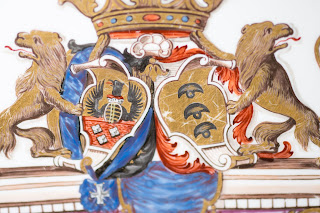
Regarded as the first of the private commission services at Meissen, it is a remarkable piece of ceramic history with a fascinating tale to tell.
 |
Prince Alexander Joseph Sulkowski,
from an 18th century painting
in Leszno city museum.
|
Alexander Joseph Graf von Sulkowski was Privy Councillor, Minister of State, and a Cabinet Minister to the King, Frederick Augustus. He was deeply involved in the Meissen factory, taking responsibility for the deliveries of porcelain to furnish the newly built ‘Porcelain Palace’ in Dresden, and also being responsible for the King’s treasure vaults in Dresden, known as the ‘Green Vaults’.
His origins & ascent to power is a tale in itself. Born to Polish gentry, rumour has it his mother fell under the spell of Augustus II ‘The Strong’, Elector of Saxony and King of Poland ( and creator of the Meissen porcelain factory!). Augustus II was known as ‘The Strong’ for his musculature, a nickname reinforced by his favourite party trick of apparently ripping iron horseshoes in half with his bare hands….. But there is another aspect to his nickname, the results of which were a debatable 354 illegitimate children!
 |
| Augustus II 'The Strong', detail from a 19th century copy of a portrait of circa 1720 by Louis de Silvesre |
Rumour has it that Alexander was one such child, and certainly Augustus II cared for the youth who came to the Royal Court at Warsaw in 1711 as a page. He entered the service of the crown prince, Frederick Augustus, who was one year younger, and they grew up together. He received his first title in 1712, ‘Master of the Horse’, and for the next seven years he & the Crown Prince went travelling through Italy, France, and the other German states. A couple of teenagers seeing the sights of Europe together, who can imagine what adventures they had…. certainly it would have been a bonding experience, and so Augustus was well established to rise in status in the court. He became a ‘Gentleman of the Bedchamber’ in 1726, married a court Lady-in-waiting in 1728, and became a Count in 1732. On 1st February 1733, Augustus II ‘The Strong’ died, and his heir Frederick Augustus ascended the throne. Straight away, Alexander was made Privy Councillor, Minister of State, Cabinet Minister and an Imperial Count. He also became a Count of the Holy Roman Empire. He was a Pole, and the only Pole to achieve such a lofty position in the court at that time. Like a Shakespearian play, the scene was set for his fall.....
What is fascinating is that this very service has been blamed for his descent; it was so much showier & desirable than the King’s own services, and more importantly, he had not asked permission from the King – the owner of the works – before putting in his order. Certainly, he lost favour at the exact same time the pieces began to be delivered, and so Sulkowski lost his many positions of privilege & responsibility to another of Frederick Augustus’s ministers, Heinrich Graf von Brühl. Brühl takes on most of Sulkowski’s titles, including Director of the Meissen works, and straight away commissions his own grand, Baroque service – the delightful & iconic ‘Swan Service’.
The National Gallery already has a magnificent charger from Brühl’s service, and these two marvelous Meissen chargers will soon be housed together in the same cabinet – let's hope they get along, and let past disagreements of their respective owners remain as history!
What is fascinating is that this very service has been blamed for his descent; it was so much showier & desirable than the King’s own services, and more importantly, he had not asked permission from the King – the owner of the works – before putting in his order. Certainly, he lost favour at the exact same time the pieces began to be delivered, and so Sulkowski lost his many positions of privilege & responsibility to another of Frederick Augustus’s ministers, Heinrich Graf von Brühl. Brühl takes on most of Sulkowski’s titles, including Director of the Meissen works, and straight away commissions his own grand, Baroque service – the delightful & iconic ‘Swan Service’.
 |
| Meissen Sulkowsky Service plate, Rosenberg Collection, Geelong. Sulkowsky Service charger, National Gallery of Victoria, Melbourne. |
The National Gallery already has a magnificent charger from Brühl’s service, and these two marvelous Meissen chargers will soon be housed together in the same cabinet – let's hope they get along, and let past disagreements of their respective owners remain as history!



